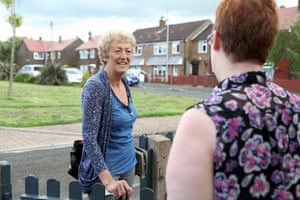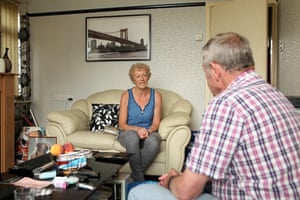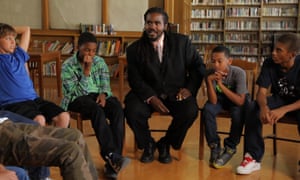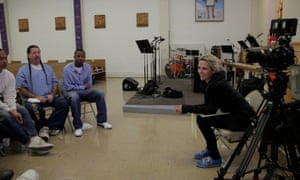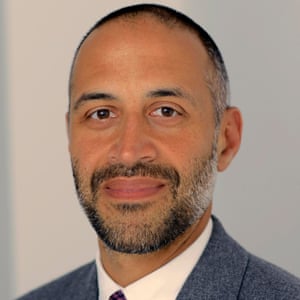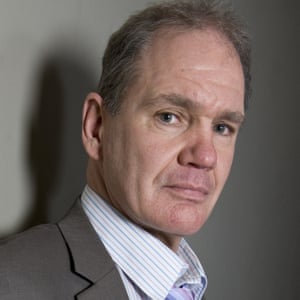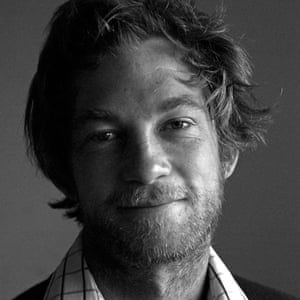The last time Eve Ensler and I met, she was sporting a sleek black bob and shiny boots, and had Jane Fonda on her arm. It was 10 years ago, when Hollywood actors were falling over themselves to perform her hit play, the Vagina Monologues, in front of audiences who got a thrill out of hearing stars say “cunt” on stage. Back then, post-feminism was still the height of fashion, Sex And The City was still on air, and I was growing tired of celebrity froth and rude words being passed off as radicalism. Ensler recalls finding me “intense and scary, and hostile to everything we were doing”.
Since that interview, a great deal has happened. The complacency of post-feminism has been replaced by a new, much more indignant movement of grassroots groups such as Vagenda and UK Feminista. Ensler has very nearly died from uterine cancer. She has also created a global women’s campaign called One Billion Rising, which on Valentine’s Day last year brought close to one billion women out on to the streets to protest against violence towards women, and will do so again next Friday. This time round, we find each other so unrecognisably altered that the interview dissolves into unexpected intimacy, and by the time we say goodbye, I am quite shaken.
Link to video: Eve Ensler: ‘Women will rise up and take back the Congo for the Congolese’
The contrast is striking as soon as I arrive. Her Manhattan loft is done out in colourful drapes fashioned from Indian saris, and she bounces around it with an unselfconscious ease in her own skin that is arresting and compelling. Her pre-cancer bob has been replaced by a more haphazardly friendly crop, and the old angular severity and faint air of ambition have vanished. With less than three weeks to go, preparations for OBR are reaching fever pitch and Ensler is buzzing, because it looks as though its second year will be even bigger than its first.
The idea behind it is both simple and fantastically ambitious. According to UN figures, one in three women on the planet will be beaten or sexually assaulted. That works out at one billion women, so Ensler wants a billion to gather on 14 February outside buildings that represent justice – police stations, courthouses, government offices – and dance. That’s it. Where and how they dance is up to them; each gathering is organised at a local level. In Miami, they plan to stop the traffic, to highlight sex trafficking; in Peru, they’re getting construction workers to carry placards renouncing street harassment. The sole unifying principle is that they dance to end violence against women. Last year, women and men danced in more than 200 countries.
Ensler always says that when she first began organising Valentine’s Day events back in 1998, she assumed violence against women would by now be a thing of the past. Her V-Day movement was obviously going to stop men beating women, and eradicate rape and sexual assault from the planet. She never dreamed, she likes to say, that 15 years later she would have to come up with an even bolder solution, but I’d always taken this for rhetorical playfulness. She didn’t seriously believe she could end all sexual violence against women, did she?
“Well, that’s a good question.” Ensler grins. “Here’s what I think. Look at slavery. It’s utterly barbaric. How could a practice like that absolutely exist, ever? So, raping women? Same thing. How could that exist? So part of me goes, of course it has to end now! We have to have an idea that it’s possible to end this. Because if we all keep going around as if, well, it’s just part of what life is, it’s part of the human condition, it’s who men are, it becomes permanently normalised, right? So, yes, I do hold an idea that it’s possible. Absolutely. I wouldn’t keep doing this work if I didn’t. I’d be an insane person. Now, obviously it hasn’t happened yet. But at the same time, the world has changed. We are talking about violence against women, it is on the front page of newspapers. It wasn’t 16 years ago. So it has changed, and that makes me think, why can’t we end it? I’m going to believe it’s possible until I leave this world, because that gets me up in the morning. And if that’s a pipe dream, so be it.”
Ensler was always an idealist, but never planned on becoming a global activist. When she wrote the Vagina Monologues in 1996, she was a minor playwright just hoping to see it staged in a tiny downtown New York theatre. It has since been produced in 140 countries, in multiple languages, and Ensler discovered that audiences all over the world were laughing and crying in exactly the same places.
“So then I began to understand that this worldwide violation of women, this denial of desire or pleasure, this blaming of women for their sexuality when they are abused, is actually universal. When you’re fighting female genital mutilation in Gambia, or you’re fighting gang rape in Congo, or you’re fighting acid burning in Pakistan, you are in your world believing this is happening in your culture, because it’s specific to your local reality. But when you suddenly understand that violence against women is the methodology that sustains patriarchy, then you suddenly get that we’re in this together. Women across the world are in this together.”
Educated western women struggle to see parallels between their reality and an Afghan villager’s, say, so the concept of global patriarchy is a tough sell, isn’t it? “The so-called liberated women?” she blinks. “I’m not buying all of that. If we look at this country, 300,000 girls on college campuses in America are sexually assaulted every year. Is that an end to oppression? One out of three in the US military is raped by their comrades? So we’re not talking about an end to that violence, absolutely not.”
 Ensler in The Vagina Monologues. Photograph: Robbie Jack/Corbis
Ensler in The Vagina Monologues. Photograph: Robbie Jack/Corbis
Up to this point, I’m with Ensler. But I’ve always taken for granted that rational argument is the way to get change, whereas she says, “We should be hysterical. Yes, I really think so. I mean, look at what’s going on! Sometimes I think we’ve all learned how to be so well-behaved and polite, and there are many clever people, and we have access to so much information – but the world is still falling at its knees. We have 85 people who make the same amount as 3.5 billion. We have one in three women on the planet being raped or beaten. And all our best thinking – thinking – has brought us here. All this great information is just spinning more information. Where is the action part, which is about rising up to do something about it? Until that thinking is translated into the body, and we are feeling what is happening, nothing is going to get us to motivate to change. I mean,” she begins to laugh in amazement, “I love that people think theorising is stronger than dancing. I love that they think that’s a stronger way of changing the world.”
Isn’t it? I ask her to explain why I am wrong. “Where do I begin? Last year, close to one billion people danced, and here are the things that happened. In the buildup to the dancing, coalitions came together that have never come together before. They understood their body, they understood their sexuality, they understood love. They were able to see themselves working together in ways they couldn’t do before.”
Ensler is in good company, for if the new feminist movements have one thing in common, it’s an aversion to prescriptive ideological programmes. All this inclusivity has been good at bringing a new generation of women to feminism, but I wonder how far it can be sustainable once they get down to the business of working out what actually to do. Ensler knows that nothing will change until women are economically equal, which is both true and a tall order, but is she saying men are basically violent towards women because they have the economic power to get away with it – or do only damaged men damage women?
She sighs. “I’ve been thinking about violence against women for 16 years, and I wish I could tell you I was closer to an understanding of what motivates men to do it. But I have a few theories. One is that we bring up boys to be disconnected from their hearts at a very young age. What are the defining qualities for a man? That you don’t cry.
“Let’s just stay with that. If I had not been allowed to cry in my life, I would be either dead or in a mental institution. What is the one thing you can do when all else fails? You can cry. You can get rid of the trauma. What if you don’t have that? Where does it go? It goes into self-hatred, it goes into rage, it goes into shame – and somebody’s going to pay the price for that. When men get angry and frustrated, they beat up their wives. And once you are far enough dissociated from yourself, anything’s possible. Imagine a man on top of a woman who’s screaming no no no, and he’s continuing. Where is he, that he doesn’t feel what she’s saying? He’s gone.”
Ensler talks very quickly, often with a cadence not unlike a charismatic preacher’s, in sentences that build and rally and roll in a great rhythmic refrain. But when I ask why she thinks her own father raped and beat her senseless throughout her childhood, her face freezes, and the words come slowly and haltingly.
“I think, umm… I think my father wanted control. Control was a very big thing for my father’s generation. They were taught to be in control of their feelings, their family – in control.” She pauses. “And I think when anything felt out of his control – his emotions, maybe his feelings towards me, an autonomous being doing things he didn’t tell me to do – it was absolutely unbearable.” After another pause, she adds quietly, “There is an insane sadism that comes from believing you have a right to control other people. And when people don’t let you do that, it just gets deeper and more psychotic.
“The other piece was that my father didn’t know what to do with his sexual feelings. I think there are many parents who have sexual feelings towards their children, and we don’t have any discourse around that. What do you do with those feelings? People punish the child for evoking those feelings.”
 Mexico 2004: Ensler, Jane Fonda and Sally Field on the frontline of a protest in Juarez. Photograph: Getty Images
Mexico 2004: Ensler, Jane Fonda and Sally Field on the frontline of a protest in Juarez. Photograph: Getty Images
Ensler was born in a middle-class suburb of New York 60 years ago, to a rather glacial housewife and a domineering corporate executive who began abusing her when she was a few years old. Her mother never intervened, and her younger sister witnessed the violence helplessly. As soon as she was old enough to leave home, Ensler took a lot of class-A drugs, had a lot of promiscuous sex, became an alcoholic, lived in communes and numbed her way through her 20s until she met her husband. She cleaned up, worked with homeless women, campaigned against nuclear weapons, got divorced in her mid-30s and became a small-time playwright on the beatnik downtown New York scene, until, at 43, she wrote the Vagina Monologues and the sexual violence of her childhood became the motor of her existence.
Fay Weldon once said, “Rape is not the worst thing that can ever happen to a woman, if you are safe, alive and unmarked afterwards.” Germaine Greer has argued something similar, claiming, “It is not women who have decided that rape is so heinous, but men.” Is it just possible, I ask Ensler, that we have accorded rape greater emotional power than it merits?
“That is just the most ludicrous thing I’ve ever heard.” She looks stricken, and speaks slowly and deliberately. “I know what rape does. What people don’t understand about rape – and it’s so hard to communicate – is it’s not an act, it’s a life. It robs you of dignity, agency, choice. It is an invasion that renders you incapable of trust, and makes intimacy one of the most terrifying things. A woman in Haiti said something brilliant to me – she said it makes sex something you’re obsessed with but can never enjoy. The sexual assault and the beatings by my father made me leave my body, and you know, I am 60 years old and it is only this year that I’m finally able to actually purge his negative and dark projections into me, and reinhabit my own body.”
Had I asked if she thought she inhabited her own body when we met a decade ago, she would have said yes without any hesitation. She’d done years of therapy and had just written a play, The Good Body, all about women’s relationships with their bodies. But when Ensler began passing blood five years ago, and her stomach distended, and she suffered terrible indigestion, and felt nauseous, she decided not to pay attention. By the time she finally saw a doctor, cancer had spread. It was stage III, nudging stage IV, and the odds of her surviving were bleak. How could she of all people have ignored what her body was telling her?
“I know, I know.” She smiles. “Cancer was just like a smash into the wall – like, ‘Girl, you are so not in your body, you are so not paying attention to yourself.’ But I had things to do! When my doctor called to tell me I had cancer, he said, ‘I have two things to say, and you have to listen to me. You cannot go to Haiti tomorrow. And you have cancer.’ He had to say them in that order because he was sure I would keep going, because my body was secondary to everything. I didn’t value it.”
Ensler believes she got cancer because her body became literally sick of the compulsion to keep proving herself. “I had to prove I wasn’t stupid, I had to prove that I was somebody, I had to prove that I could do it all on my own. And I think I had gone as far as I could go. I thought, what is the point of this – am I going to do this for ever? Am I going to prove myself to death?”
I’d been expecting a fairly straightforward conversation about Ensler’s work with OBR, but as she talks about cancer, I feel myself turn cold with fear, because the self she is describing sounds horribly recognisable. If that’s why she got ill, then I’m in trouble. Ensler is not the first person to talk about cancer in these terms, but the peculiar persuasiveness of her intimacy makes me blurt out: “The truth is, I’ve got no idea what ‘being in the body’ even means. I’ve only ever lived in my head.”
It’s true; for as long as I can remember, my body just seemed like a troublesome inconvenience, the least important thing I could think of. “I could have told you that about you,” Ensler says. “And it’s so important to get in your body. Can I tell you, it’s different in here [motioning to her heart]. And it’s really good.”
But I don’t think I ever really feel much about anything, I admit. I just think and do.
I’m amazed to hear myself telling her this, but she looks unsurprised. “Oh God, I so relate. I had a tumour the size of a mango and I didn’t even notice. And you know what, where are we going with all that fancy head stuff? We’re achieving and doing, but where the fuck are we going? When I sat there and they said to me, the cancer might be in your liver, it was like a new world. Wake the fuck up, sister. And I bless it. Because I don’t know what else would have taken me there. Can I tell you, I am now the happiest I have been in my life. Profoundly. I’m working from a different engine now; I don’t have to work, I want to. And that was the beginning of this life, which is so good.”
Is she saying she is glad she got cancer? “Are you kidding? Of course I am. I wasn’t in the beginning. But then I really got it. Because I realised I was disconnected from everything and everybody. And there is such a loneliness with it. Once you live in your body, you can just be.”
She studies me again. “How much are you living to prove yourself?”
Don’t we all have to prove ourselves? Nothing comes unconditionally.
“Bullshit. It’s all bullshit. I’m convinced that the core of everything that is wrong on this planet is people feeling that they are not good enough. But there is nothing to prove. You don’t have to do anything. You know, I don’t really give a fuck if you’re a good interviewer. I actually like you – not your do, but you.”
But we are what we do, aren’t we? “No. No. No!” Deep down I think I’ve always known this must be true, but Ensler is the first person who has ever made it sound believable. She grips my hand. “Let me tell you something, if you keep going on this path you will get sick, it’s inevitable.”
This doesn’t really feel like an interview any more. The last time we met, if someone had told me that our next encounter would end with me asking her how I go about getting back into my own body, I would have said they were mad. But she can get A-listers to perform a play about vaginas, persuade a billion people to dance, and believes she can end rape, so I don’t know why I’m surprised. She is one of the most powerfully magnetising personalities I’ve ever met.
We stand and she hugs me. “You don’t have to get cancer to come back into your own body, you really don’t. I got to do it so you don’t have to. You think your body is just an engine, a machine to move you along. Let me tell you, I love my body so much now, I adore this body. I’m missing seven organs and 70 nodes, and I’m functioning. How could I not love this body?”
Eve Ensler: "We need to be hysterical about sexual violence"
